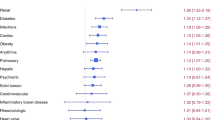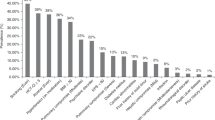Summary:
Comorbid conditions have not been studied systematically for impact upon patient outcome in the setting of hematopoietic stem cell transplantation (HSCT). Patients formerly excluded from myeloablative transplant due to comorbid illnesses now receive reduced-intensity conditioning regimens; hence, the incidence of comorbid conditions in HSCT recipients is expected to increase. Comorbid grading systems developed without regard for oncology patients have been applied in retrospective fashion to HSCT patients. Two commonly used scales (Charlson Comorbidity Index and the Adult Comorbidity Inventory-27) fail to include critical information: tumor and histologic type/stage, extent of prior treatment, donor stem cell source and cell type and preparative regimen. Further, data are reported in retrospective rather than prospective fashion. Despite limitations, however, such grading systems exhibit ease and utility for evaluation and may have predictive value for patient outcome. Modifying such approaches to include additional factors and appropriate weighting of components may enable an improved comparison of techniques and study results. These scoring systems may elucidate predictors of outcome and disease natural history and enhance statistical efficiency methods of HSCT. Refined scoring could be used effectively to assign patients to differing transplant conditioning regimens, that is, myeloablative vs reduced intensity. Prospective validation of such grading systems is encouraged.
This is a preview of subscription content, access via your institution
Access options
Subscribe to this journal
Receive 12 print issues and online access
$259.00 per year
only $21.58 per issue
Buy this article
- Purchase on Springer Link
- Instant access to full article PDF
Prices may be subject to local taxes which are calculated during checkout
Similar content being viewed by others
References
Feinstein AR . The pre-therapeutic classification of comorbidity in chronic disease. J Chronic Dis 1970; 23: 455–468.
Popplewell LL, Forman SJ . Is there an upper age limit for bone marrow transplantation? Bone Marrow Transplant 2002; 29: 277–284.
Yancik R . Epidemiology of cancer in the elderly. Current status and projections for the future. Rays 1997; 22: 3–9.
Loberiza F . Report on the state of the art in blood and marrow transplantation. Part 1 of the IBMTR/ABMTR summary slides with guide. IBMTR/ABMTR Newsletter, 2003, Vol 10, pp 7–10.
Bolwell BJ . Are predictive factors clinically useful in bone marrow transplantation? Bone Marrow Transplantation 2003; 32: 853–861.
Zangari M, Henzlova MJ, Ahmad S et al. Predictive value of left ventricular ejection fraction in stem cell transplantation. Bone Marrow Transplant 1999; 23: 917–920.
Fujimaki K, Maruta A, Yoshida M et al. Severe cardiac toxicity in hematological stem cell transplantation: predictive value of reduced left ventricular ejection fraction. Bone Marrow transplant 2001; 27: 307–310.
Hertenstein B, Stefanic M, Schmeiser T et al. Cardiac toxicity of bone marrow transplantation: predictive value of cardiologic evaluation before transplant. J Clin Oncol 1994; 12: 998–1004.
Jain B, Floreani AA, Anderson JR et al. Cardiopulmonary function and autologous bone marrow transplantation: results and predictive value for respiratory failure and mortality. The University of Nebraska Medical Center Bone Marrow Transplantation Pulmonary Study Group. Bone Marrow Transplant 1996; 17: 561–568.
Lehmann S, Isberg B, Ljungman P, Paul C . Cardiac systolic function before and after hematopoietic stem cell transplantation. Bone Marrow Transplant 2000; 26: 187–192.
Goldberg SL, Klumpp TR, Magdalinski AJ et al. Value of the pretransplant evaluation in predicting toxic 100-day mortality among blood stem cell and bone marrow recipients. J Clin Oncol 1998; 16: 3796–3802.
Crawford SW, Fisher L . Predictive value of pulmonary function tests before marrow transplantation. Chest 1992; 101: 1257–1264.
Carlson K, Backlund L, Smedmyr B et al. Pulmonary function and complications subsequent to autologous bone marrow transplantation. Bone Marrow Transplant 1994; 14: 805–811.
Chien JW, Madtes DK, Clark JG . Pulmonary function testing prior to hematopoietic stem cell transplantation. Bone Marrow Transplant 2005; 35: 429–435.
McDonald GB, Hinds MS, Fisher LD et al. Veno-occlusive disease of the liver and multiorgan failure after bone marrow transplantation: a cohort study of 355 patients. Ann Intern Med 1993; 118: 255–267.
Chen PM, Liu JH, Fan FS et al. Liver disease after bone marrow transplantation – the Taiwan experience. Transplantation 1995; 59: 1139–1143.
Rozman C, Carreras E, Qian C et al. Risk factors for hepatic veno-occlusive disease following HLA-identical sibling bone marrow transplants for leukemia. Bone Marrow Transplant 1996; 17: 75–80.
Carreras E . Veno-occlusive disease of the liver after hemopoietic cell transplantation. Eur J Haematol 2000; 64: 281–291.
Zager RA, O’Quigley J, Zager BK et al. Acute renal failure following bone marrow transplantation: a retrospective study of 272 patients. Am J Kidney Dis 1989; 13: 210–216.
Gruss E, Bernis C, Tomas JF et al. Acute renal failure in patients following bone marrow transplantation: prevalence, risk factors and outcome. Am J Nephrol 1995; 15: 473–479.
Karnofsky DA, Burchenal JH . The clinical evaluation of chemotherapeutic agents in cancer. In: Macleod CM (ed). Evaluation of Chemotherapeutic Agents. Columbia University Press: New York, 1949, pp 191–205.
Zubrod Cl . Clinical investigations in cancer chemotherapy. J Chronic Dis 1958; 8: 183–190.
Weisdorf D, Bishop M, Dharan B et al. Autologous versus allogeneic unrelated donor transplantation for acute lymphoblastic leukemia: comparative toxicity and outcomes. Biol Bloood Marrow Transplant 2002; 8: 213–220.
Robin M, Guardiola P, Dombret H et al. Allogeneic bone marrow transplantation for acute myeloblastic leukemia in remission: risk factors for long term morbidity and mortality. Bone Marrow Transplant 2003; 31: 877–887.
Deeg HJ, Seidel K, Bruemmer B et al. Impact of patient weight on non-relapse mortality after marrow transplantation. Bone Marrow Transplant 1995; 15: 461–468.
Navarro WH, Loberiza FR, Bajorunaite R et al. Impact of weight on mortality of patients with lymphoma undergoing autologous hematopoietic cell transplantation (AHCT) (abstract #3342). Proc ASCO 2003; 22: 832.
Linn BS, Linn MW, Gurel L . Cumulative illness rating scale. J Am Geriatr Soc 1968; 16: 622–626.
Pool DA, Brown RA . A functional rating scale for research in physical therapy. Tex Rep Biol Med 1968; 26: 133–136.
de Groot V, Beckerman H, Lankhorst GJ, Bouter LM . How to measure comorbidity. A critical review of available methods. J Clin Epidemiol 2003; 56: 221–229.
Extermann M . Measuring comorbidity in older cancer patients. Eur J Cancer 2000; 36: 453–471.
Extermann M . Measurement and impact of comorbidity in older cancer patients. Crit Rev Oncol Hematol 2000; 35: 181–200.
Charlson ME, Pompei P, Ales KL, MacKenzie CR . A new method of classifying prognostic comorbidity in longitudinal studies: development and validation. J Chronic Dis 1987; 40: 373–383.
Mulrow CD, Gerety MB, Cornell JE et al. The relationship between disease and function and perceived health in very frail elder patients. J Am Geriatr Soc 1994; 42: 374–380.
Rochon EA, Katz JN, Morrow LA et al. Comorbid illness is associated with survival and length of hospital stay in patients with current disability. A prospective comparison of three comorbidity indices. Med Care 1996; 34: 1093–1101.
Parkerson GR, Broadhead E, Tse C . The Duke Severity of illness checklist (DOSOI) for measurement of severity and comorbidity. J Clin Epidemiol 1993; 46: 379–393.
Paleri V, Wight RG . Applicability of the adult comorbidity evaluation-27 and the Charlson indexes to assess comorbidity by notes extraction in a cohort of United Kingdom patients with head and neck cancer: a retrospective study. J Laryngol Otol 2002; 116: 200–205.
Greenfield S, Apolone G, McNeil BJ, Cleary PD . The importance of co-existent disease in the occurrence of post-operative complications and one year recovery in patients undergoing total hip replacement. Comorbidities and outcomes after hip replacement. Med Care 1993; 31: 141–154.
Ramaker C, Marinus J, Stiggelbout AM, Van Hilten BJ . Systematic evaluation of rating scales for impairment and disability in Parkinson's disease. Mov Disord 2002; 17: 867–876.
Hemmelgarn BR, Manns BJ, Quan H, Ghali WA . Adapting the Charlson Comorbidity Index for use in patients with ESRD. Am J Kidney Dis 2003; 42: 125–132.
Fleming ST, Pearce KA, McDavid K, Pavlov D . The development and validation of a comorbidity index for prostate cancer among black men. J Clin Epidemiol 2003; 56: 1064–1075.
Yancik R, Wesley MN, Ries LAG et al. Comorbidity and age as predictors of risk for early mortality of male and female colon carcinoma patients. A population-based study. Cancer 1998; 82: 2123–2134.
Fleming ST, Rastogi A, Dmitrienko A, Johnson KD . A comprehensive prognostic index to predict survival based on multiple comorbidities: a focus on breast cancer. Med Care 1999; 37: 601–614.
Shahjahan M, Alamo J, de Lima M et al. Effect of comorbidities on allogeneic hematopoietic stem cell transplant outcomes in AML/MDS patients in first complete remission. Biol Blood Marrow Transplant 2004; 10 (Suppl 2): 12–13.
Sorror ML, Maris MB, Storer B et al. Comparing morbidity and mortality of HLA-matched unrelated donor hematopoietic cell transplantation after nonmyeloablative and myeloablative conditioning: influence of pretransplantation comorbidities. Blood 2004; 104: 961–968.
Diaconescu R, Flowers CR, Storer B et al. Morbidity and mortality with nonmyeloablative compared with myeloablative conditioning before hematopoietic cell transplantation from HLA-matched related donors. Blood 2004; 104: 1550–1558.
Pollyea D, Artz A, Stock W et al. Clinical predictors of transplant related mortality after reduced intensity allogeneic stem cell. Blood 2004; 104 (abstract 1145).
Sorror ML, Maris MB, Storb RF et al. Hematopoietic cell transplantation (Hct)-specific-comorbidity index: a new tool for risk assessment before allogeneic HCT. Biol Blood Marrow Transplant 2005 (abstract #57).
Black NA, Jenkinson C, Hayes JA et al. Review of outcome measures used in adult critical care. Crit Care Med 2001; 29: 2119–2124.
Extermann M, Bonetti M, Sledge GW et al. MAX2 – a convenient index to estimate the average per patient risk for chemotherapy toxicity; validation in ECOG trials. Eur J Can 2004; 40: 1193–1198.
Extermann M, Chen H, Cantor AB et al. Predictors of tolerance to chemotherapy in older cancer patients: a prospective pilot study. Eur J Can 2002; 38: 1466–1473.
Sorror M, Maris M, Baron F et al. A modified hematopoietic cell transplantation (HCT)-specific-comorbidity index. Blood 2004; 104 (abstract 1146).
Author information
Authors and Affiliations
Corresponding author
Rights and permissions
About this article
Cite this article
Alamo, J., Shahjahan, M., Lazarus, H. et al. Comorbidity indices in hematopoietic stem cell transplantation: a new report card. Bone Marrow Transplant 36, 475–479 (2005). https://doi.org/10.1038/sj.bmt.1705041
Received:
Accepted:
Published:
Issue Date:
DOI: https://doi.org/10.1038/sj.bmt.1705041
Keywords
This article is cited by
-
Retrospective study of the digestive tract mucositis derived from myeloablative and non-myeloablative/reduced-intensity conditionings with busulfan in hematopoietic cell transplantation patient
Supportive Care in Cancer (2019)
-
Patient anxiety and concern as predictors for the perceived quality of treatment and patient reported outcome (PRO) in orthopaedic surgery
BMC Health Services Research (2012)
-
A modified comorbidity index for hematopoietic cell transplantation
Bone Marrow Transplantation (2010)
-
Cost and effectiveness of reduced-intensity and conventional allogeneic hematopoietic stem cell transplantation for acute myelogenous leukemia and myelodysplastic syndrome
Supportive Care in Cancer (2010)
-
Impact of comorbidity indexes on non-relapse mortality
Leukemia (2008)



